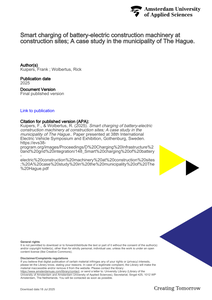This paper investigates smart charging strategies for battery-electric construction machinery (non-road mobile machinery, NRMM) through a case study of a large-scale housing project in The Hague, Netherlands. The study develops a methodology to estimate energy demands and simulate charging profiles during various construction phases. Using a combination of smart charging and temporary battery storage, the paper demonstrates that peak grid loads can be significantly reduced—by up to 46%—compared to conventional charging strategies. Simulations reveal that grid limitations, especially during early construction phases, can be overcome with optimized load management and supplemental battery systems. The findings highlight the importance of smart charging infrastructure and energy planning in enabling the transition to zero-emission construction practices. This research contributes to the practical implementation of electric NRMM in urban construction projects, addressing one of the key bottlenecks in decarbonizing the construction sector.
DOCUMENT

This report focuses on the feasibility of the power-to-ammonia concept. Power-to-ammonia uses produced excess renewable electricity to electrolyze water, and then to react the obtained hydrogen with nitrogen, which is obtained through air separation, to produce ammonia. This process may be used as a “balancing load” to consume excess electricity on the grid and maintain grid stability. The product, ammonia, plays the role of a chemical storage option for excess renewable energy. This excess energy in the form of ammonia can be stored for long periods of time using mature technologies and an existing global infrastructure, and can further be used either as a fuel or a chemical commodity. Ammonia has a higher energy density than hydrogen; it is easier to store and transport than hydrogen, and it is much easier to liquefy than methane, and offers an energy chain with low carbon emissions.The objective of this study is to analyze technical, institutional and economic aspects of power-to-ammonia and the usage of ammonia as a flexible energy carrier.
DOCUMENT

The adaptivity of façades is increasingly recognized as an important functional feature to be integrated with the state-of–the-art building technology. The aim is thereby to control its reversible system states in real-time to adapt to current indoor and outdoor conditions. Concepts reported elsewhere integrate two or more functions related to structural integrity, ventilation, heating and cooling, solar protection, as well as energy generation and storage. Although advantages are perceived obvious, the number of realized case studies remains limited. Triggered by this observation, the authors of this contribution report research findings from a literature study and interviews with stakeholders in the field, including contractors, building consultants and architects. The three key-findings suggest that (1) the functions daylighting and energy generation/storage are most commonly integrated into façades or façade components characterized as being adaptive, (2) interviewees are divided on the implementation potential of most of the designs/concepts and (3) the aesthetics of the design, (investment) costs, durability and required maintenance are critical for a widespread market uptake. Herewith, this paper contributes new knowledge to the discussion related to finding the right level of system integration in building technology.
MULTIFILE

Surface Active Agents, or surfactants, are chemicals which provide a surface (interface) activity when dispersed in liquids. They have different purposes, can be used as herbicides, anti-foaming agents, adhesives, cleaning agents and softeners. For cleaning purposes, their function is to alter (decrease) liquid surface tension. In this function they are ubiquitous in both industrial processes (cleaning of production equipment, storage vats, packaging lines, and cooking units either during the manufacturing process) and domestic applications. ProtoNeat proposes an alternative way to decrease water surface tension without adding chemicals (surfactants). This can be done by charging the water (producing protonically charged water) [2], i.e. positive and negative Bjerrum-defect like charges [3, 4]. This phenomenon was experimentally observed by Fuchs et al [5] in anolyte and catholyte when doing high voltage electrolysis of highly pure water during the so-called ‘floating water bridge’ experiment. The work done by the authors, when working with this “bridge”, showed that, in case of positive excess charge, the hydronium ions migrate to the surface [8] thereby significantly lowering the surface tension [9,10]. However, for how long this effect can be maintained and how effective it is to produce such water is still unknown. ProtoNeat wants to tackle these two questions and investigate whether a continuous production of protonically charged water as an environmentally friendly and sustainable cleaning agent is possible.